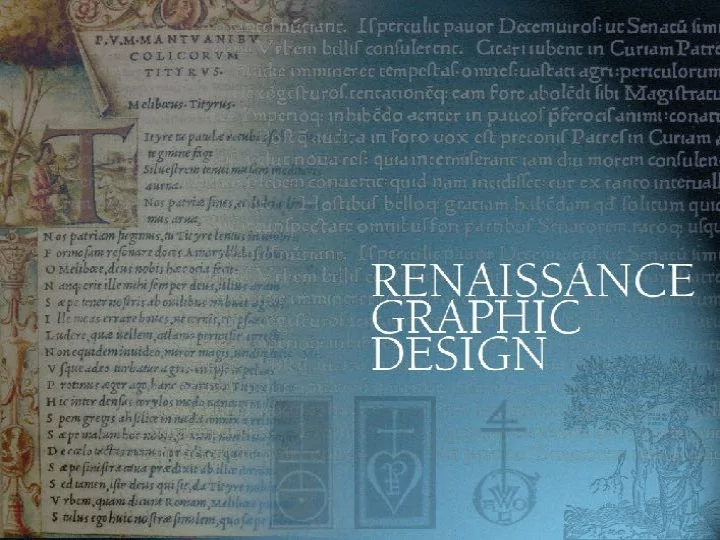

Copperplate engravings allowed the popular use of fine hand-inscribed scripts.
Copperplate engravings George Bickham (the Elder) was an English writing master and engraver. He is best known for his engraving work in The Universal Penman .
George Bickham The Universal Penman was a collection of writing exemplars which helped to popularize the English Round Hand script in the 18th century.
Typography in England Since the 17 th century, typography and printing was hindered by censorship, religious persecution and government control.
In 1660, King Charles II demanded that the number of printers be reduced to twenty “by death or otherwise.”
William Caslon Started as an apprentice to a London engraver of gunlocks and barrels. He later opened his own shop adding gilding and letterstamping for bookbinders.
A printer suggested he try type design and foundry – which he did and then designed Caslon Old Style in 1720.
For nearly 60 years, all of England used Caslon type. This carried over to the American colonies where it was the only type used.
John Baskerville Started his career as a writing teacher and a stonecutter of gravestones.
John Baskerville He made his fortune manufacturing Japanned ware: durable pieces of lacquered hand-painted items.
Laid cold press Woven hot press Baskerville developed a denser black ink made from varnish and linseed oil. He manufactured the first smooth “hot press” paper.
Laid cold press Woven hot press For 500 years the English produced coarse laid papers from screens made of parallel wires. Baskerville developed special fine mesh screens to produce his smooth wove papers.
Baskerville refined the roman typeface in what became a transitional roman style: straighter strokes with more contrast than the traditional Old Style type.
Baskerville designed books without flowers, ornaments, or decorated initials — just pure, elegant type with wide margins and open spacing.
The Modern Style Following along the trends established by Fournier and Baskerville, Giambattista Bodoni developed a new design for type in Italy.
Bodoni admired the work of Baskerville. In 1790, he created a modern type with longer ascenders, descenders and thick straight vertical strokes and slab serifs.
Bodoni’s layouts abandoned the ornate rococo style that had gone out with the French Revolution. His became the signature style of the modern era.
Critics hailed Bodoni’s Manuale tipographico of 1818 as the typographical expression of “neoclassicism”. His crisp letterforms featured extreme weight contrasts between the thick and thin strokes.
Pierre Didot The Didots were a family dynasty of printers in France during the mid 1700s. Pierre Didot took Bodoni’s elegant simplicity and refined it further, perfecting the neoclassical style.
Neoclassical Graphic Design The trend of typographical simplicity during the second half of the 18th century in Europe saw the increasing influence of classical antiquity on artistic style and graphic design.
Neoclassical Graphic Design artistic style and graphic design. Simple, elegant page designs illustrated in detailed copperplate engravings were typical of the books dedicated to science, nature and new editions of the Greek and Roman classics. Such neoclassicism meant a return to “antique virtue.”
Stereotyping The Didot foundry invented stereotyping: a process that made a duplicate matrix of relief to be cast into metal plates
The Didot type foundry experimented with fat and thin typefaces similar to what we now call expanded and condensed fonts.
Pierre Didot By 1818, both Giambatista Bodoni and Pierre Didot pushed the modern style of roman typography to the limit.
Modern (also called didone ) type characteristics
Modern Roman fonts Bodoni Didot Modern
Infographics In the late 1700s, William Playfair used mathematical formulas to convert statistical data into symbolic graphics.
In 1786, Playfair published the Commercial and Political Atlas , a book that tracked England’s imports and exports by statistics, allowing trade surpluses and deficits to be seen at a glance.
But even two decades before Playfair began visualizing data, Joseph Priestly had begun recording timelines .
By the 18 th century, infographics were used to analyze the logistics of war in myriad ways, plotting information across lines of time and space.
Thomas Bewick and William Bulmer Bewick and Bulmer worked together as engraver and printer producing many of the finest books on nature history of the time.
Thomas Bewick Bewick achieved a remarkable tonal range by combining white and black lines in his wood engravings.
Wood Engraving Using a fine stylus to hand-engrave illustrations from blocks of wood rather than copper plates, Bewick’s “white line”tonal effect became a major illustration method in letterpress printing.
Recommend
More recommend